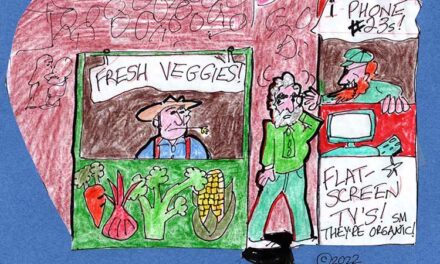Going To Disneyland? Bring A Co-Signer
The Magic Kingdom redoubles its efforts to rip off the working poor
By Ed Goldman
🎼
“When you wish upon a star,
Just make sure you have a car
That you’ll sell so you can take
Your loving brood
“To a Disney Park or two
Even though your rent is due.
They’ve raised prices drunkenly–
And You. Are. Screwed.”
Disneyland, the former “happiest place on earth” and “magic kingdom,” may soon need to fight payroll processor ADP for its name as it rebrands itself “Anaheim Debtors’ Prison.®”
While its attendance figures are up-up-up, so are its prices for damn near everything- thing-thing: park passes, wristband discounts, rides, food, merch, and possibly even sordid encounters with Ursula the Sea Witch.
The writing on the wall
The Disney money-people—I believe their names are Mephistopheles, Beelzebub and Donald—came up with a new paradigm for the amusement park I first went to in its second week of existence in 1955: charge more for everything, cut down on costs, rip off the working poor.
What might the latter mean for you, your kids and grandkids hoping to head there over Thanksgiving next month? Other than your needing a co-signer to buy a kids’ meal at Hungry Bear Restaurant in Critter Country, here’s a rundown of 10 changes you should be aware of:
- Autopia—the mini-freeway on which tots can “drive” gas-powered cars that are safely secured on a track—now consists only of mini-Teslas, which your little ones will need to learn how to recharge every 15 seconds. Fortunately, there are 70 mini-charging stations along the route of the five-minute ride; unfortunately, each charge will cost you 15 Disney dollars (roughly $147 in American currency). The company accepts neither cryptocurrency nor cryptic remarks.
- Mister Toad’s Wild Ride now features huge puppets based on the title villain of “Anaconda” along the route. Better bring an extra diaper for the kids, a Depends for you.
- Pirates of the Caribbean now has real pirates, not robotic avatars. They’ve been fashioned after lawyers from both sides of the Johnny Depp-Amber Herd trial, which captivated the country even longer and more fully than the insurrection hearings.
- The ride, Indiana Jones Adventure: Temple of the Forbidden Eye, has been updated to depict Harrison Ford at his current age (80) and is now “presented” by AARP. Instead of snakes, Nazis and tumbling boulders, Indy’s new challenges are ungrateful grown kids, estate executors and falling arches.
- The Peter Pan’s Flight attraction is now interrupted halfway through to allow an animatronic psychologist to explain what “Peter Pan” syndrome is to impressionable children who may have been contemplating never growing up, getting decent dead-end jobs nor ever having sex. At ride’s end, a concessionaire will be on hand to sell the kids tiny business suits, high heels, whole-life insurance policies. This is, park officials assure us, strictly non-binary swag. (First drafts of suicide notes sold separately.)
- The Matterhorn rollercoaster has become a journey into nihilism and rechristened the Doesn’tMuchMatterhorn. Kids will discover that the ride mimics the mediocrity of life, with its takes-forever-to-get-to highs followed by life’s very fast downward plummets. As always, a costumed Yeti “greets” riders at the peak of the attraction and either hands out Nietzsche comic books or mauls select riders.
- Great Moments with Mr. Lincoln still features the animatronic Great Emancipator but now, in the tradition of woke politics, he apologizes for the delay in abolishing slavery, for sowing the defeat of Robert E. Lee without designating someone to say to him, “Thank you for your service” —which “Lincoln” admits was a toxic male move on my part”—and, most tellingly, for ruining the audience’s enjoyment of “Our American Cousin” at the Ford’s Theatre on April 14, 1865. “I feel especially bad about this one,” he says, “because it was a Friday night crowd and everyone was there just to, y’know, chillax. Then that guy John Wilkes Booth shows up. Actors!”
- Jungle Cruise now features a driving tour of a scaled-down replica of the San Francisco Bay Area during Rush Hour..
- Instead of having weird little singing-doll puppets in outfits from all over the globe, It’s a Small World will now have duplicates of U.S. Congressman Kevin McCarthy; U.S. Senators Kyrsten Sinema, Lindsey Graham and Joe Manchin; as well as Celebrity Doorknobs Sarah Palin and Herschel Walker. All will list their legislative accomplishments (estimated time: 6.3 seconds), then demonstrate their knowledge of the U.S. Constitution in the hope of joining Mensa. Not advised for sensitive children or adults not wearing Depends.
- The Haunted Mansion now denies admission to anyone without a reversible mortgage unless they bring a signed excusal note from Tom Selleck.
Ed Goldman's column appears almost every Monday, Wednesday and Friday. A former daily columnist for the Sacramento Business Journal, as well as monthly columnist for Sacramento Magazine and Comstock’s Business Magazine, he’s the author of five books, two plays and one musical (so far).
Yes, Virginia
A Weekly Blog by Virginia Varela
President, Golden Pacific Bank, a Division of SoFi Bank, Inc.
photo by Phoebe Verkouw
What makes employees happy at work and want to stay at their place of employment?
Money is necessary to meet the most basic needs of employees, but it is not their primary motivator. Monetary incentives cannot compensate for all aspects of how much individuals enjoy their jobs, either.
As “Leading Outside the Lines” authors Katzenbach and Khan suggest: “Money encourages self-serving short-term behaviors better than it motivates lasting institutional achievement.” In other words, money is a way to attract and retain the workforce—but it does not influence the behavior at work.”
Why do we want happy employees?
First, there’s a very real cost for losing an employee—thousands of dollars, in many cases. Professional research suggests that every time a business replaces a salaried employee, it costs 6 to 9 months’ salary on average. Replacement costs can be as high as 50%-60% with overall costs ranging anywhere from 90%-200%.
Example: If an employee makes $60,000 per year then it costs an average of $30,000 – $45,000 just to replace that employee and roughly $54,000 – $120,000 in overall losses to the company.
Moreover, three out of four employee resignations can be prevented. Company turnover can be reduced by 29% to 59 percent if employees are aligned and engaged. According to a 9/23/2020 Morgan McKinley recruitment article, there are five key motivators within the workplace:
– Provide meaningful and challenging work;
– Improve employees’ lives;
– Recognition;
– Compensation and benefits; and
– Culture.
If you’re an employer, the best part of this list is that if you provide this sort of environment for your employees, they won’t be the only ones who are happy. You will be, too.
sponsored content












